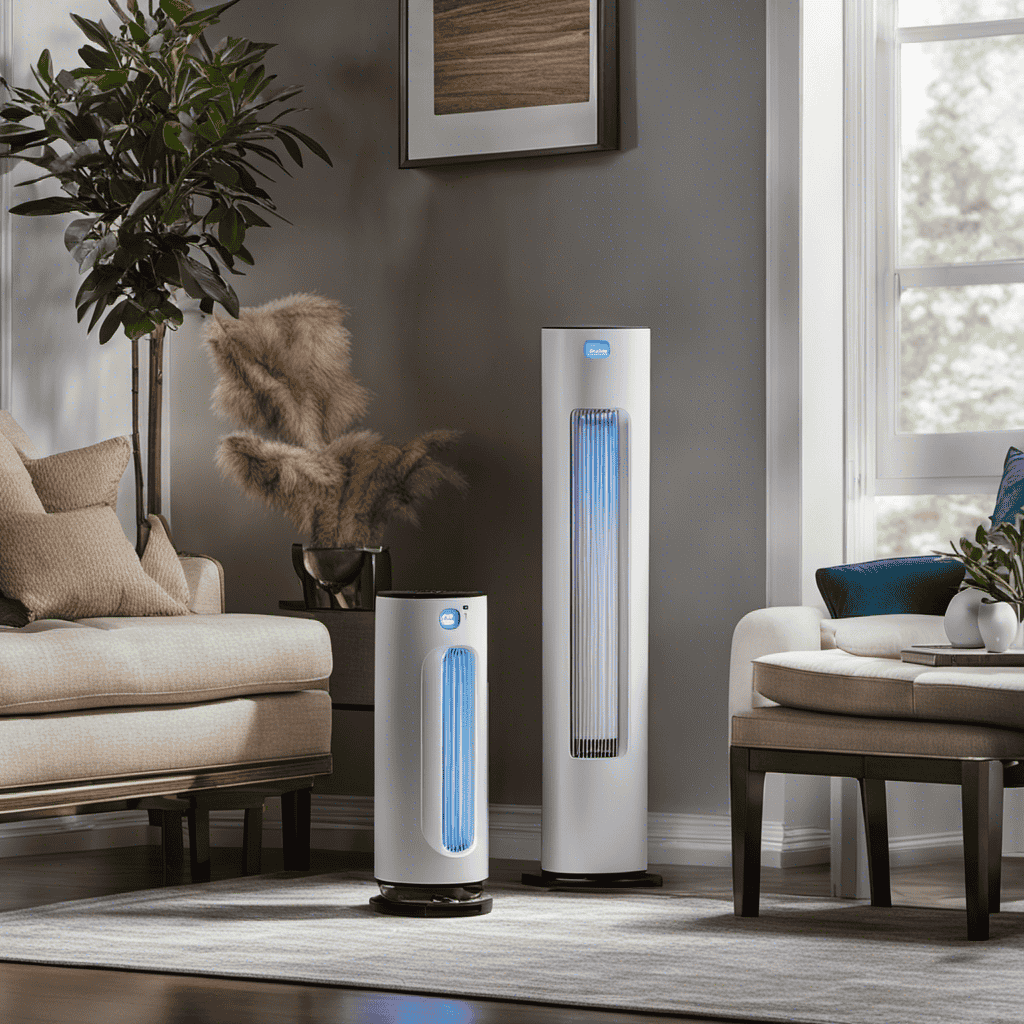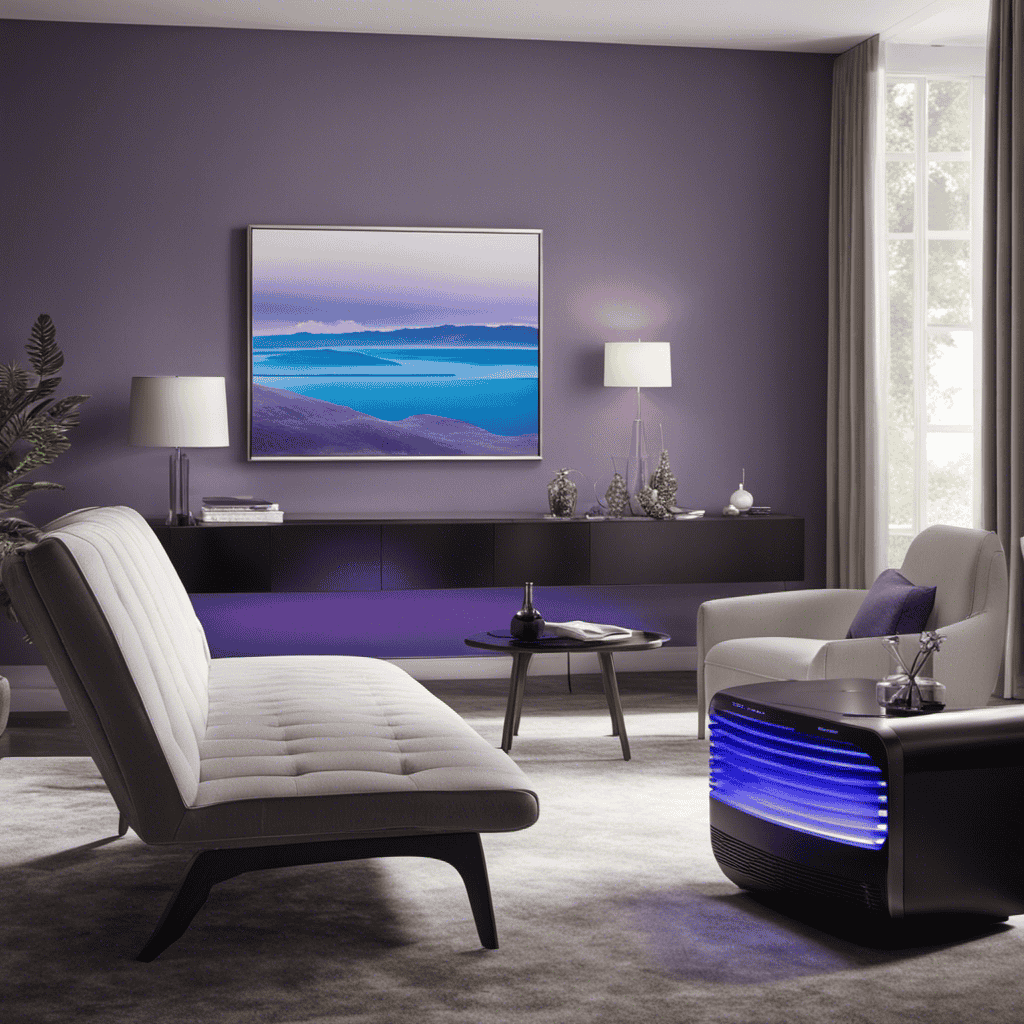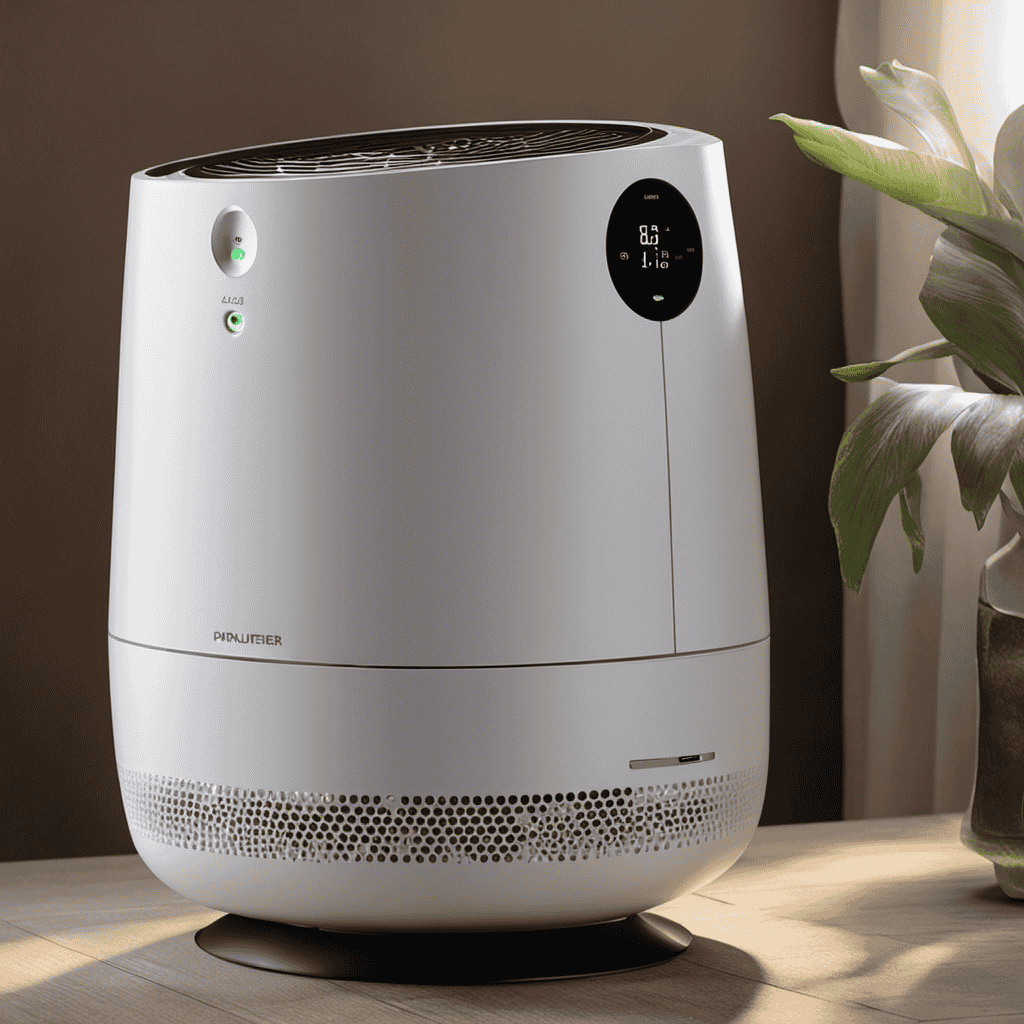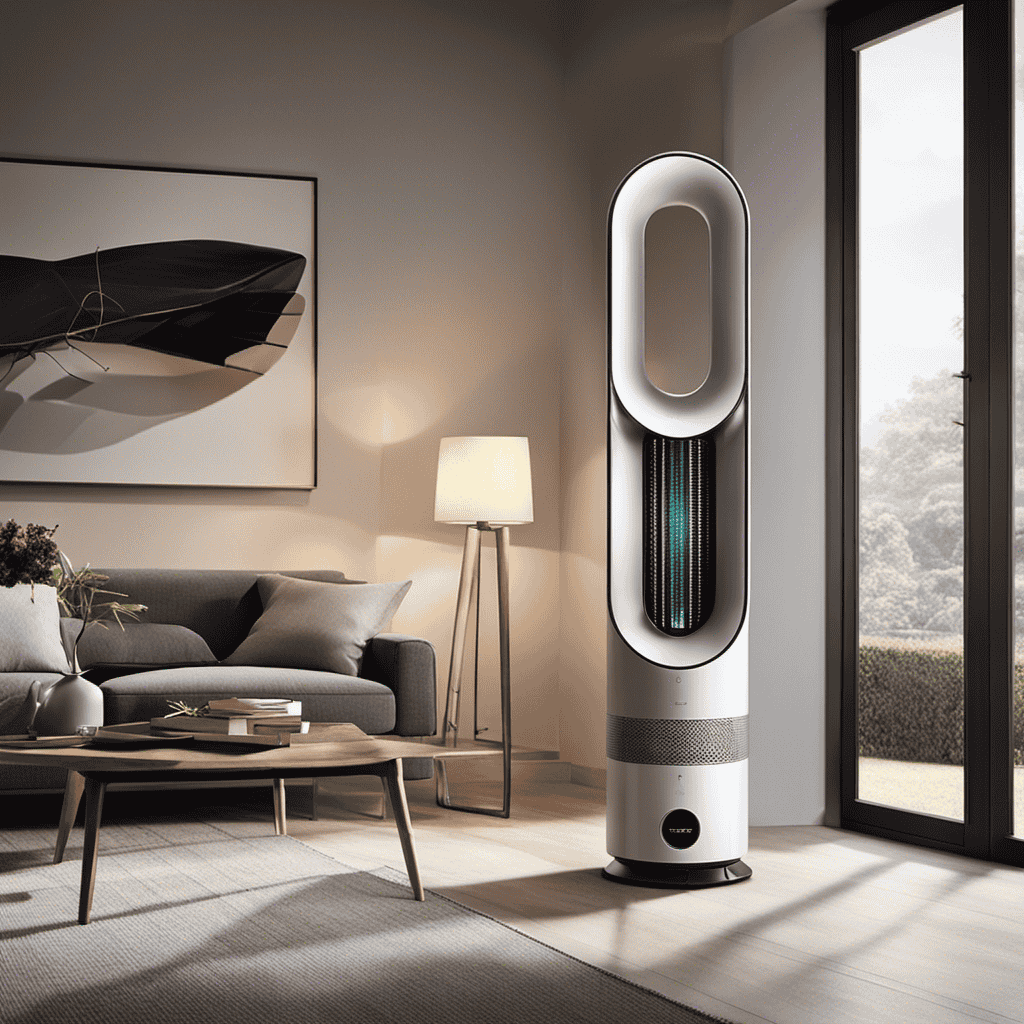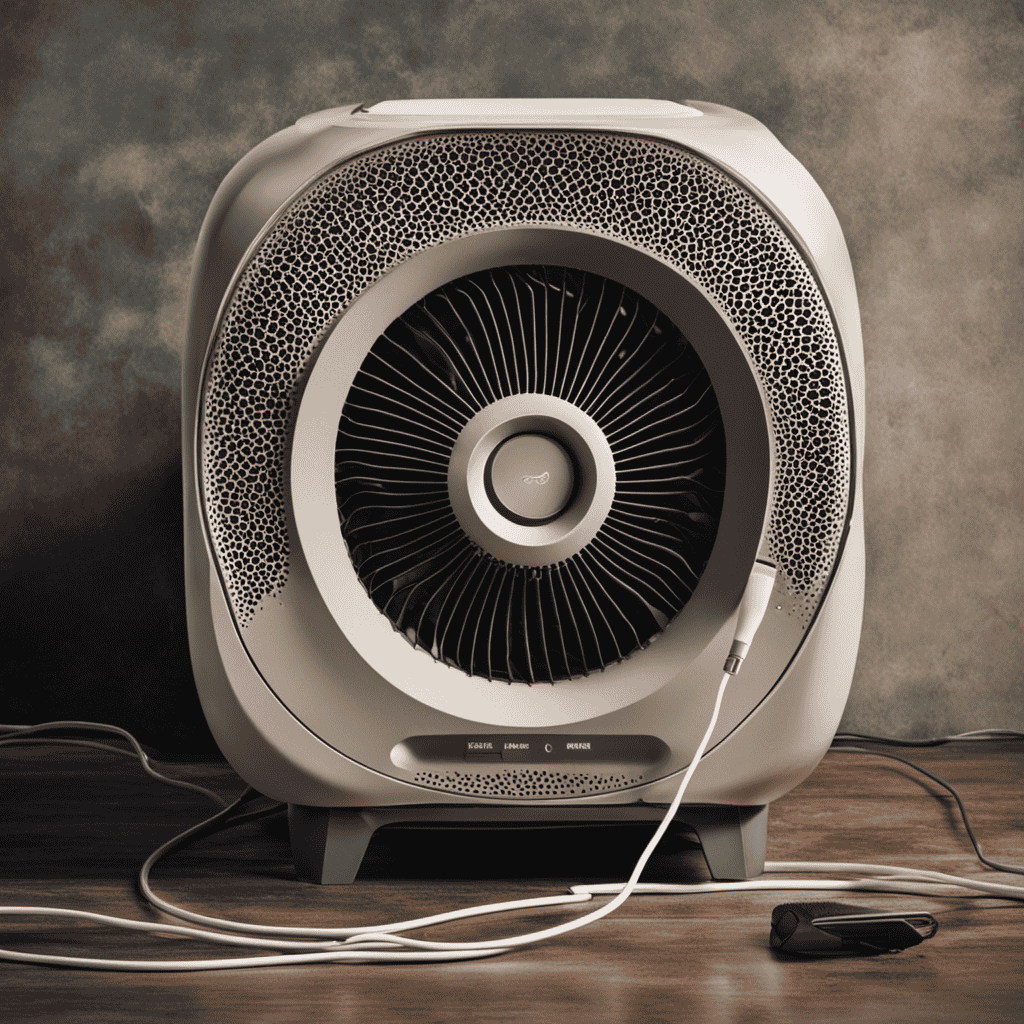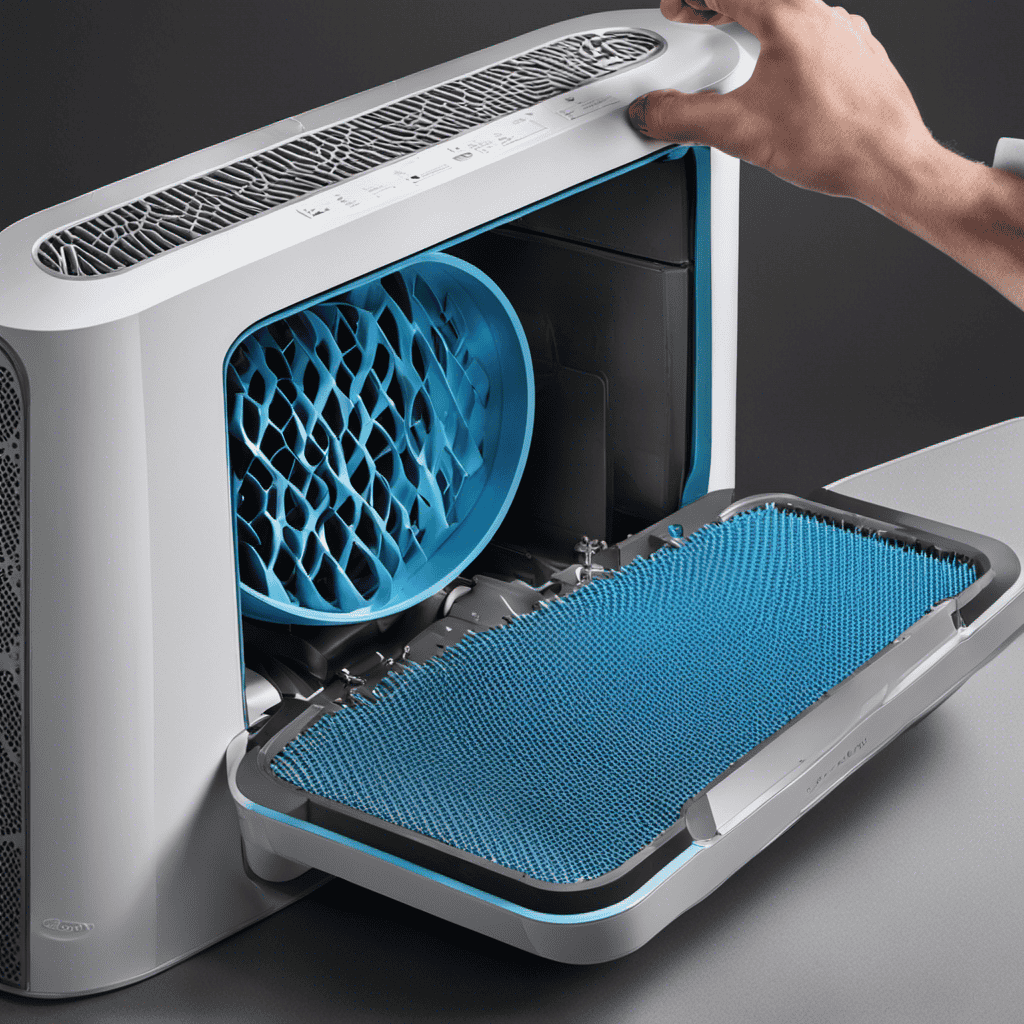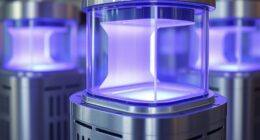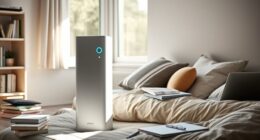I’ve always been curious about the functioning of an ionic air purifier.
Did you know that these devices utilize negatively charged ions to remove harmful particles from the air?
In this article, I will explore the fascinating world of ionic air purifiers, discussing their benefits, key features to look for, common misconceptions, and tips for choosing the right one.
Additionally, I’ll provide maintenance and care tips to help keep your air purifier running smoothly.
Let’s dive in and uncover the secrets behind these powerful devices!
Key Takeaways
- Ionic air purifiers utilize negatively charged ions to remove harmful particles from the air.
- The emission of negative ions allows them to attach to positively charged particles like dust, pollen, and smoke, making them heavier and causing them to settle down, effectively removing them from the air.
- Using an ionic air purifier improves overall air quality and reduces allergens and irritants.
- Ionic air purifiers have the benefits of removing harmful particles, reducing allergens, eliminating unpleasant odors, killing bacteria and viruses, and being a low maintenance and cost-effective option for long-term use.
How Does an Ionic Air Purifier Work
To understand how an ionic air purifier works, you need to know that it uses charged ions to remove pollutants from the air.
The ionization process involves the emission of negative ions into the air, which attach themselves to positively charged particles like dust, pollen, and smoke.
These charged particles become heavier and eventually settle down, effectively removing them from the air.
This process not only improves the overall air quality but also reduces the presence of allergens and irritants in the environment.
Ionic air purifiers are especially effective in eliminating airborne bacteria and viruses, further enhancing the cleanliness of the air.
By utilizing the power of ions, these purifiers provide a natural and efficient way to clean the air we breathe.
Now, let’s explore the benefits of using an ionic air purifier.
Benefits of Using an Ionic Air Purifier
One of the benefits of using an ionic air purifier is that it can help to remove harmful particles from the air. This is important for improving air quality and maintaining respiratory health. Ionic air purifiers work by emitting negatively charged ions that attach to positively charged particles in the air, causing them to become heavy and fall to the ground.
Here are some additional benefits of using an ionic air purifier:
-
Reduces allergens: Ionic air purifiers can effectively remove allergens such as pollen, pet dander, and dust mites from the air, providing relief for allergy sufferers.
-
Eliminates odors: These purifiers can also help to eliminate unpleasant odors caused by cooking, pets, and smoke, leaving the air clean and fresh.
-
Kills bacteria and viruses: The ions released by the purifier can disrupt the structure of bacteria and viruses, effectively neutralizing them and reducing the risk of airborne illnesses.
-
Low maintenance: Ionic air purifiers do not require regular filter replacements, making them a cost-effective option for long-term use.
Key Features to Look for in an Ionic Air Purifier
When it comes to choosing an air purifier, there are a few key points to consider.
First and foremost is the effectiveness of the air purification system. This includes understanding how ionization technology works and its role in removing pollutants from the air.
Additionally, it is important to understand the maintenance requirements of the purifier, including the frequency of filter replacement.
Effective Air Purification
If you’re looking for an effective air purification method, consider using an ionic air purifier. These devices are designed to improve indoor air quality by removing airborne pollutants.
Here are some reasons why ionic air purifiers are a great choice:
-
Ionization process: Ionic air purifiers use ionization technology to charge particles in the air, making them stick to surfaces or collect in the purifier’s filter.
-
Efficient filtration: The charged particles are attracted to negatively charged plates inside the purifier, effectively capturing pollutants like dust, allergens, and bacteria.
-
No ozone production: Unlike some other air purification methods, ionic air purifiers do not produce ozone, which can be harmful to human health.
-
Silent operation: Ionic air purifiers work silently, making them ideal for use in bedrooms or offices where noise can be a concern.
By understanding how ionic air purifiers work, you can better appreciate the benefits they offer in improving indoor air quality.
Now let’s delve into the details of ionization technology explained.
Ionization Technology Explained
To understand how ionization technology works, you need to know that it charges particles in the air, causing them to stick to surfaces or collect in the filter. This technology is a key component of many air purifiers, providing effective air purification benefits.
Ionization technology works by releasing negative ions into the air. These ions attach to dust, pollen, and other airborne particles, giving them a positive charge. The charged particles then become attracted to surfaces or the filter in the air purifier, effectively removing them from the air you breathe. This process helps to eliminate pollutants and allergens, improving indoor air quality.
Numerous studies have shown the effectiveness of ionization technology in reducing airborne particles and improving respiratory health. With its ability to capture particles and improve air quality, ionization technology is a valuable tool in ensuring cleaner and healthier air.
Now that you understand how ionization technology works, let’s explore the importance of maintenance and filter replacement in keeping your air purifier running at its best.
Maintenance and Filter Replacement
Now that we understand how ionization technology works in an ionic air purifier, let’s delve into the maintenance and filter replacement aspect of these devices.
To ensure optimal performance and efficiency, regular filter cleaning is necessary. This can be done by gently vacuuming or rinsing the filters, depending on the manufacturer’s instructions.
Additionally, it is important to estimate the lifespan of the filters to know when they need to be replaced. The lifespan of the filters can vary depending on factors such as air quality, usage, and the specific model of the air purifier. However, on average, the filters may need to be replaced every 6 to 12 months.
It is always recommended to refer to the user manual or contact the manufacturer for accurate information regarding filter cleaning and replacement.
-
Perform regular filter cleaning through vacuuming or rinsing
-
Estimate the lifespan of the filters based on air quality, usage, and model
-
Replace the filters every 6 to 12 months on average
-
Refer to user manual or contact manufacturer for specific instructions and information.
Common Misconceptions About Ionic Air Purifiers
Did you know that there are several common misconceptions about ionic air purifiers?
Many people believe that these devices produce harmful ozone, but the truth is that most modern ionic air purifiers emit only trace amounts of ozone, well within the safety limits set by regulatory agencies.
Another misconception is that ionic air purifiers remove all types of air pollutants. While they are effective at removing certain particles like dust and pollen, they may not be as effective at removing gases, chemicals, or odors.
Additionally, some people think that ionic air purifiers are noisy, but in reality, they operate silently as they don’t have any fans or motors.
Overall, it’s important to understand these common misunderstandings about ionic air purifiers to make informed decisions about indoor air quality.
Tips for Choosing the Right Ionic Air Purifier for Your Needs
When it comes to choosing the right ionic air purifier for your needs, there are several key features to consider. These features include the type of filtration system, the size and capacity of the unit, and the noise level it produces.
Additionally, it is important to assess the compatibility of the purifier with the size of the room you intend to use it in, as different models have different coverage areas.
Lastly, regular maintenance and filter replacement are crucial for optimal performance, ensuring that the purifier continues to effectively remove pollutants from the air.
Features to Consider
One important feature to consider when choosing an ionic air purifier is its coverage area. This refers to the size of the space that the purifier can effectively clean. A larger coverage area is ideal for bigger rooms or open-concept spaces, while a smaller coverage area is suitable for smaller rooms or personal spaces.
When evaluating ionic air purifiers, it is also important to consider their advanced technology. Look for features such as electrostatic precipitation or negative ion generation, which can help remove airborne pollutants effectively. Additionally, energy efficiency is another crucial factor to consider. Opt for air purifiers that are Energy Star certified or have energy-saving modes to minimize electricity consumption.
Considering these features will help you choose an ionic air purifier that suits your specific needs. Now, let’s move on to discussing the next important feature, which is room size compatibility.
Room Size Compatibility
Considering the size of my room, it’s important to choose an ionic air purifier that is compatible with the room’s dimensions. Room size compatibility is crucial in ensuring optimal air purification.
The effectiveness of an ionic air purifier depends on its ability to circulate and purify the air within a given space. If the purifier is too small for the room, it may struggle to effectively clean the air, leaving pollutants and allergens behind.
On the other hand, if the purifier is too large for the room, it may consume unnecessary energy without providing any additional benefits. Therefore, it is essential to carefully consider the recommended room size for an ionic air purifier to ensure efficient air purification and minimize energy consumption.
Maintenance and Filter Replacement
To maintain optimal performance, make sure you regularly clean and replace the filters in your ionic air purifier. The filters play a crucial role in trapping and removing airborne particles, allergens, and pollutants from the air. Neglecting the maintenance of these filters can lead to a decline in the purifier’s efficiency and effectiveness.
Here are some important factors to consider when it comes to filter maintenance:
-
Replacement Schedule: It is recommended to follow the manufacturer’s guidelines for filter replacement. Most filters require replacement every 6 to 12 months, but this may vary depending on the model and usage.
-
Cleaning Techniques: Filters can also be cleaned to extend their lifespan. Vacuuming or rinsing them with water can help remove larger particles. However, it is important to note that not all filters are washable, so always check the manufacturer’s instructions before attempting to clean them.
-
Regular Inspection: It is advisable to inspect the filters regularly for any signs of damage or excessive dirt buildup. If the filters appear worn out or clogged, it is time to replace them.
-
Filter Quality: Investing in high-quality filters is essential for better air purification. Look for filters that are specifically designed for your ionic air purifier and have a high efficiency rating.
Maintenance and Care for Ionic Air Purifiers
Regular maintenance is essential for keeping your ionic air purifier in optimal condition. To ensure its efficiency and longevity, it is important to follow proper cleaning techniques and troubleshooting tips.
Begin by unplugging the device and removing the collection plates or filters. Gently clean the plates with a soft brush or cloth to remove any accumulated debris or dust particles. For filters, check the manufacturer’s instructions for cleaning or replacement guidelines.
Additionally, regularly wipe down the exterior of the air purifier with a damp cloth to remove any surface dust. If you encounter any issues, such as unusual noises or reduced airflow, consult the user manual for troubleshooting tips or contact the manufacturer for further assistance.
Frequently Asked Questions
How Much Electricity Does an Ionic Air Purifier Consume?
An ionic air purifier consumes a minimal amount of electricity, making it energy-efficient. This low electricity consumption reduces its environmental impact. The exact amount of electricity consumed depends on the model and usage duration.
Can an Ionic Air Purifier Remove Cigarette Smoke Odor?
Yes, an ionic air purifier effectively removes cigarette smoke odor. Its ionizing technology attracts and neutralizes smoke particles, eliminating the odor. The benefits of using an ionic air purifier include improved air quality and a fresher living environment.
Are Ionic Air Purifiers Safe to Use Around Pets and Children?
I have found that ionic air purifiers may pose potential health risks when used around pets and children. Additionally, their effectiveness in removing airborne contaminants is not as reliable as traditional filter-based purifiers.
Do Ionic Air Purifiers Require Filter Replacements?
Yes, ionic air purifiers require filter replacements. The cost of maintaining them can be high. However, they are still effective without filter replacements, making them a convenient option for clean air.
Can an Ionic Air Purifier Eliminate All Types of Allergens and Pollutants From the Air?
An ionic air purifier can effectively eliminate various allergens and pollutants from the air, providing numerous benefits. It uses ions to attract and remove particles, improving indoor air quality.
Conclusion
In conclusion, after thoroughly researching and understanding the mechanics of an ionic air purifier, I am convinced of its undeniable benefits. The ability to remove harmful particles from the air we breathe is an invaluable asset to our overall well-being.
However, there are still misconceptions surrounding these purifiers, which is why it is crucial to choose the right one for your specific needs. By investing in proper maintenance and care, your Ionic Air Purifier will continue to provide you with clean, fresh air, ensuring a healthier environment for you and your loved ones.
